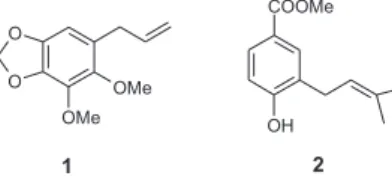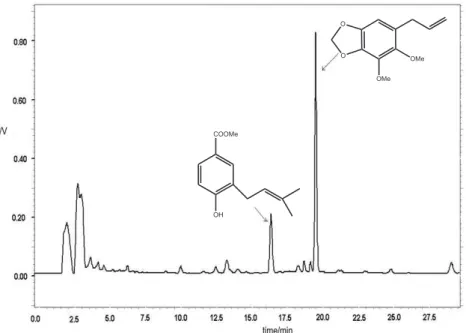J. Braz. Chem. Soc., Vol. 16, No. 6B, 1439-1442, 2005. Printed in Brazil - ©2005 Sociedade Brasileira de Química 0103 - 5053 $6.00+0.00
Article
* e-mail: smnunomu@inpa.gov.br
Quantitative HPLC Analysis of some Marker Compounds of Hydroalcoholic
Extracts of
Piper aduncum
L.
Laura C. P. Oliveiraa, Robert Mauseb and Sergio M. Nunomura*,a
a
Coordenação de Pesquisas em Produtos Naturais, Instituto Nacional de Pesquisas da Amazônia, CP 478, 69083-000 Manaus - AM, Brazil
b
Siema Eco Essências da Amazônia Ltda, Conjunto Colina do Aleixo, 69083-600 Manaus - AM, Brazil
A cromatografia líquida de alta performance vem sendo uma das principais técnicas empregadas no controle de qualidade de produtos fitoterápicos. Nesse trabalho é descrito um método de quantificação dos componentes principais presentes em diferentes extratos hidroalcoólicos de partes aéreas de Piper aduncum.
High performance liquid chromatography is one of the major analytical techniques used in the quality control of phytoterapics. This work describes a HPLC method used to determine the major components present in different hydroalcoholic extracts of aerial parts of Piper aduncum.
Keywords: Piperaceae, methyl 4-hydroxy-3-(3´-methyl-2´-butenyl)-benzoate, dillapiol, phytotherapy
Introduction
Plants have always played an important role for the mankind, especially as food and medicine. Some ancients as Assyrians, Arabs, Egyptians and Greeks left a legacy of over a thousand years of medicinal plants use. They have discovered not only their medicinal properties, but also some dose-related effects of the plants and their extracts.1
Despite the major advances in the modern medicine, the development of new drugs from natural products is still considered important. This seems to be even more relevant for the developing countries, where the costs to develop a drug are prohibitive. Since 1980, the World Health Organization has been encouraging countries to identify and exploit traditional medicine and phytotherapy.2 In Brazil, phytotherapy is a promissing
alternative due to its biodiversity and many studies devoted to the description of plant chemistry and their biological activities.
However the development of phytotherapeutical products is dependent on their standardization, to guarantee not only the authenticity of the plant extract, but also to enable a dose-related use. Chromatographic methods have been
recom-mended to the quality control of phytotherapeutical products with many advantages over other methods.3-5
The genus Piper is widely spread and many species present important biological activities.6,7 In the present
study, we have studied some hydroalcohol extracts from the aerial parts of Piper aduncum L., popularly known as “aperta-ruão”. P. aduncum was registered in the First Edition of Brazilian Pharmacopeia8 and many studies
in the literature describe its phytochemicals and its antimicrobial effects.9,10 This work describes part of the
efforts for the standardization and quality control of hydroalcohol extracts of P. aduncum, based on the HPLC quantification of some marker compounds. This was a colaborative work with Siema Eco Essências da Amazônia, a company that develops an antimicotic product trademarked as Dermodilapiol from aerial parts of Piper aduncum.
Experimental
Plant material and extracts
1440 Oliveiraet al. J. Braz. Chem. Soc.
located in Manaus, whereas the fourth batch from cultivated specimens collected at Itacoatiara City. Voucher specimens are deposited in the INPA herbarium under the numbers 214711 and 21334. The extracts were prepared by maceration of ca. 4.0 kg of dried and powdered aerial parts with ca. 40 L of ethanol:water (96:4) for seven days at room temperature. The material was then filtered and the concentration of the final product was adjusted to reach a final concentration of 20 g L-1 of extractives.
HPLC analysis
The analyses were performed on a Shimadzu LC-10 system equipped with a LC-10AD pump, Rheodyne valve, SPD-10AVP detector with dual-mode, CBM-10A interface and Class VP 6.1 data system. A Shimpak ODS column (250 mm x 4.6 mm, 5 μm) from Shimadzu was used in all analyses. Separations were achieved on linear gradient of acetonitrile: aqueous TFA 0.05 % (0 min – 49:51; 10 min – 49:51; 12 min – 65:35; 25 min – 65:35; 30 min – 100:0), at a flow rate of 1 mL min-1, injection volume of 20 μL (“loop”) and UV
detection at 254 and 280 nm simultaneously. All deter-minations were carried out in triplicate.
Isolation of the marker compounds
Previous HPLC analysis of the extracts had showed that all four batches had two major components (marker compounds). After several chromatographic steps (liquid-liquid partition, normal and reversed-phase column chromatography, preparative thin-layer chromatography), 94 mg of marker compound 1 and 18 mg of the marker compound 2 have been isolated.
Identification of the marker compounds
The isolated marker compounds were identified on the basis of their spectroscopical data (NMR and MS) and comparison with published data. The chemical marker
1 was identified as being the phenylpropanoid dillapiol, whereas 2 as the benzoic acid derivative methyl 4-hydroxy-3-(3´-methyl-2´-butenyl)-benzoate (Figure 1). Both
compounds had been previously isolated from P. aduncum.9-12
Dillapiol. 1H NMR (CDCl
3, 200 MHz): 6.35 (s, 1H), 5.88
(s, 2H), 5.80 (m, 1H), 5.07 (dd, 1H), 5.01 (sl, 1H), 4.01 (s, 3H), 3.75 (s, 3H), 3.30 (dt, 2H). 13C NMR (CDCl
3, 50 MHz):
126.1 (C), 136.0 (C), 137.7 (C), 144.6 (C), 144.2 (C), 102.8 (CH), 33.9 (CH2), 137.4 (CH), 115.3 (C), 101.1 (CH2), 61.2 (OCH3), 59.7 (OCH3). MS-EI (70 eV) m/z (Rel. int. %): 222 [M]+ (100), 195 (6), 191 (7), 177 (41), 149 (28), 121 (18), 106 (19), 91 (13), 77 (26), 65 (18), 53 (17).
Methyl 4-hydroxy-3-(3´-methyl-2´-butenyl)-benzoate. 1H
NMR (CDCl3, 200 MHz): 7.83 (s, 1H), 7.81 (d, 1H), 6.83 (d, 1H), 6.13 (sl, 1H), 5.31 (t, 1H), 3.88 (s, 3H), 3.38 (d, 2H), 1,77 (s, 6H). 13C NMR (CDCl
3, 50 MHz): 126.8 (C),
131.9 (CH), 122.6 (C), 158.6 (C), 115.5 (CH), 129.7 (CH), 29.6 (CH2), 121.1 (CH), 135.5 (C), 25.8 (CH3), 17.9 (CH3), 167.1 (C), 51.8 (OCH3). MS-EI (70 eV) m/z (Rel. int. %): 220 [M]+ (49), 165 (100), 161 (27), 133 (29), 105 (40).
Quantitative analysis
For the quantification, the external standard method was employed, using the purified marker compounds as standards. Stock solutions of 10, 20, 40 e 80 μg mL-1 of
dillapiol and 1, 2, 4 e 8 μg mL-1 of the benzoic acid
derivative were prepared in methanol. Calibration curves of dillapiol and benzoic acid derivative were obtained from the analysis at 280 and 254 nm, respectively.
Samples of each batch of the hydroalcohol extracts have been previously submitted to SPE treatment to enhance the detectability and resolution. Initially, 100 μL of the extract were diluted with 900 μL of water, eluted into a SPE cartridge (Seppak C-18 Waters) and was washed with up to 5 mL of water to elute the polar components. The cartridge was then washed with up to 10 mL of acetonitrile (ACN) to obtain a second fraction to be quantified (with the chemical markers). Before the injection, this sample was diluted with 10 mL of water to prevent undesirable separations. A third fraction eluted with additional 10 mL of ACN was obtained (apolar components). All fractions have been analysed to ensure that all components, including the marker compounds, were completely removed from the cartridge.
Results and Discussion
The sample treatment with SPE was very efficient to concentrate the interested compounds solely in the first fraction eluted with ACN. The chromatographic profiles
1441 Quantitative HPLC Analysis of some Marker Compounds
Vol. 16, No. 6B, 2005
of all batches were very similar, showing two major components (Figure 2) with good separation. The peak of each marker compound has been identified with the help of coinjection of standards.
For the quantification of dillapiol and the benzoic acid derivative, calibration curves of each marker compound have been obtained in triplicate. All calibration curves have shown good linearity in the tested range. The regression equations were y = 21004x + 2257.2 (r = 0.9939) for dillapiol and y = 42676 x 2921.5 (r = 0.9955) for the benzoic acid derivative. The relative standard deviations (RSD) for the peak areas were inferior to 2 %. The four batches have been also analysed in triplicate and the results of both marker compounds (Table 1) have shown good linearity, precision of injection and repeatability (RSD < 3 %).
Very similar chromatographic profiles were observed for all analysed hydroalcoholic extracts of aerial parts of Piper aduncum, indicating a common composition of their metabolites. The quantitative results have also shown small differences for the analysed marker compounds 1 and 2
in the four batches, indicating also that the product has a good stability, since the batches were produced along an entire year.
Conclusions
The established HPLC method has shown good linearity, precision and repeatability. The analysis time is not long and achieved good resolution for both marker compounds. These results indicate that this method may be applied to quality control this product.
Acknowledgments
This work has been supported by CNPq (Proc. No. 521138/2001-9 and 464863/01-5) and FAPEAM (Proc. No.1088/04).
References
1. Mann, J.; Murder, Magic and Medicine, Oxford University Press: New York, 1992, p. 232.
2. Akerele, O.; Fitoterapia1988, 59, 355.
3. Gyéresi, A.; Kelemen, H.; Kata, M.; J. Planar Chromatogr.
1997, 10, 172.
4. Kinghorn, A.D.; Seo, E-K.; Drug Inf. J.1998, 32, 487. 5. Celeghini, R.M.S.; Vilegas, J.H.Y., Lanças, F.M.; J. Braz. Chem.
Soc. 2001, 1, 706.
6. Parmar, V.; Jain, S.C.; Bisht, K.S.; Jain, R.; Taneja, P.; Jha, A.; Tyagi, O.D.; Prasad, A.K.; Wengel, J.; Olsen, C.E.; Boll, P.M.;
Phytochemistry1997, 46, 597.
Table 1. Marker compounds contents in four different batches of hydroalcohol extracts of aerial parts of Piper aduncum
Sample Concentration Relative Concentration Relative of 1 (mg mL-1) S.D. (%) of 2 (mg mL-1) S.D. (%)
Batch 1 4.54 ± 0.08 1.79 0.190 ± 0.002 1.03 Batch 2 5.09 ± 0.04 0.82 0.2200 ± 0,0004 0.18 Batch 3 4.81 ± 0.06 1.35 0.220 ± 0.006 2.87 Batch 4 4.05 ± 0.02 0.41 0.220 ± 0.002 0.82
1442 Oliveiraet al. J. Braz. Chem. Soc.
7. Lago, J.H.G.; Tanizaki, T.M.; Young. M.C.M.; Guimarães, E.F.; Kato, M.J.; J. Braz. Chem. Soc. 2005, 16, 153.
8. Rodolpho, A.D.S.; Pharmacopeia dos Estados Unidos do
Brasil, 1st ed., Companhia Editora Nacional: São Paulo, 1929,
p. 393.
9. Orjala, J.; Erdelmeier, C.A.J.; Wright, A.D.; Rali, T.; Sticher,
O.; Planta Med. 1993, 53, 546.
10. Burke, B.; Nair, M.; Phytochemistry1986, 25, 1427. 11. Nair, M.G.; Burke, B.A.; J. Agric. Food Chem. 1990, 38, 1093. 12. Lago, J.H.G.; Ramos, C.S.; Casanova, D.C.C.; Morandim, A.; Bergamo, D.C.B.; Cavalheiro, A.J.; Bolzani, V.S.; Furlan, M.; Guimarães, E.F.; Young, M.C.M.; Kato, M.J.; J. Nat. Prod.2004,
67, 1783.

